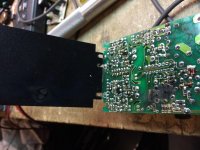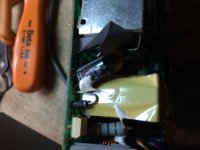Ferrix97
Well-known member
Hello!
I recently scored a couple of PowerBook 540c, together with three power bricks!
When I plugged the first one, I heard a loud POP! noise coming from the power supply.
I decided to open it using the vise and and after desoldering the bottom shield, I quickly found out what happened:

It looks like one of the capacitors leaked its electrolyte, which found it's way between the shield and the PCB, shorting two tracks together.
The capacitor that leaked was a 100uf 25V, there are only two of them on the board and they are very easy to replace

Currently the Fuse (3.15A 250V F) is blown, and I don't have a replacement on hand, but it looks like the rest of the circuitry is fine.
I'll report back once I get a new Fuse, which can be replaced without removing the bottom shield, it is in a holder soldered to the PCB, to remove it you only need to desolder one of the connections, the holder can be reused.
I recently scored a couple of PowerBook 540c, together with three power bricks!
When I plugged the first one, I heard a loud POP! noise coming from the power supply.
I decided to open it using the vise and and after desoldering the bottom shield, I quickly found out what happened:

It looks like one of the capacitors leaked its electrolyte, which found it's way between the shield and the PCB, shorting two tracks together.
The capacitor that leaked was a 100uf 25V, there are only two of them on the board and they are very easy to replace

Currently the Fuse (3.15A 250V F) is blown, and I don't have a replacement on hand, but it looks like the rest of the circuitry is fine.
I'll report back once I get a new Fuse, which can be replaced without removing the bottom shield, it is in a holder soldered to the PCB, to remove it you only need to desolder one of the connections, the holder can be reused.
